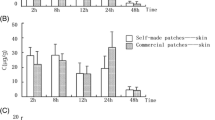Summary
The distribution coefficient of caffeine (water/n-Octanol) and the estimation of caffeine in urine after local application indicate to a high permeation rate of caffeine through the skin. This could be confirmed by using different vehicles in vivo and in vitro. 14C labeled caffeine penetrates rapidly the epidermis and corium. The maximum of absorption is reached at 100 min after local application in vivo.
In vitro by absence of the transport possibilities of blood and lymph vessels, the concentration at 1,000 min after local application is 450 x higher than in vivo. Therefore, after 1,000 min in vivo the concentration of caffeine in the different skin layers is very low.
Zusammenfassung
Nach Bestimmung des Verteilungskoeffizienten von Coffein (Wasser/n-Octanol) und nach Angaben in der Literatur ist mit einer hohen Penetration von Coffein durch die menschliche Haut zu rechnen. Dies konnte in Abhängigkeit von verschiedenen Vehikeln an menschlicher Haut in vitro und in vivo bestätigt werden. 14C-markiertes Coffein wird schnell und in einer bis zu einem Maximum nach 100 min stetig ansteigender Menge in Epidermis und Corium aufgenommen.
In vitro ist aufgrund des fehlenden Transportes durch Blut-und Lymphgefäße eine bis 450fache höhere Konzentration im Corium nach 1000 min Einwirkungszeit festellbar. Infolge der hohen Resorption in vivo ist die Konzentration nach 1000 min in der Haut nur noch äußerst gering.
Similar content being viewed by others
References
Stüttgen, G., Neumann, D.: Hemmung des Dermographismus an der menschlichen Haut nach epicutaner Applikation von Coffein. Arch. Dermatol. Forsch. 242, 229–232 (1972)
Feldmann, R. J., Maibach, H. I.: Absorption of some organic compounds through the skin in man. J. Invest. Dermatol. 54, 399–404 (1970)
Zesch, A., Schaefer, H.: Penetrationskinetik von radiomarkiertem Hydrocortison aus verschiedenen Salbengrundlagen in die menschliche Haut-in vitro. Arch. Dermatol. Forsch. 246, 335–354 (1973)
Middleton, J. D.: The mechanism of water binding in stratum corneum. Br. J. Dermatol. 80, 437–441 (1968)
Wendker, H., Schaefer, H., Zesch, A.: Penetrationskinetik und Verteilung lokal applizierter Östrogene. Arch. Dermatol. Forsch. 256, 67–74 (1976)
Zesch, A., Schaefer, H.: Penetrationskinetik von radiomarkiertem Hydrocortison aus verschieden-artigen Salbengrundlagen in die menschliche Haut.II. In vivo. Arch. Dermatol. Forsch. 252, 245–256 (1975)
Author information
Authors and Affiliations
Additional information
Supported by the P. G. Unna-Stiftung
Rights and permissions
About this article
Cite this article
Zesch, A., schaefer, H. & Stüttgen, G. The quantitative distribution of percutaneously applied caffeine in the human skin. Arch Dermatol Res 266, 277–283 (1979). https://doi.org/10.1007/BF00418573
Received:
Issue Date:
DOI: https://doi.org/10.1007/BF00418573




